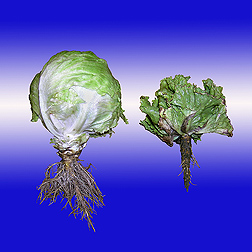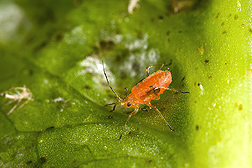February, 2007
 |
|
A
head of healthy lettuce, left, next to one infected with
corky root.
(D691-1) |
USDA
Agricultural Research Magazine
February
2007 - Vol. 55, No. 2
Cool, crisp, iceberg lettuce rates
as one of the country’s top five favorite veggies. With its
delicate, slightly sweet taste and pleasingly crunchy texture,
the humble crisphead—as it is also known—is perfect to toss with
other leafy greens for a refreshing salad. And, increasingly,
folks from coast to coast roll up their favorite sandwich
fillings—whether beef, chicken, fish, or veggies—in an iceberg
lettuce leaf as a convenient way to dodge the carbs of other
wraps, like a tortilla, for instance.
Iceberg lettuce and its relatives—the elegant romaine of Caesar
salads; the softer textured, crimson-tipped or rich-green leaf
lettuces; or the creamy butterheads like Boston and bibb—are
vulnerable to attack by an impressive array of stealthy
microbes. Some of these microbes are ferried to lettuce fields
in the saliva of piercing and sucking insects such as aphids and
whiteflies. Still others team up with fellow microbes, using
them as a means of invading susceptible lettuces.
All this moving about means the threats to a newly planted field
of your favorite lettuce can change from year to year, emerging,
destroying, and then—sometimes—mysteriously vanishing. And a
field can, of course, be besieged by more than one enemy at the
same time.
Today, breeding strong, natural resistance into lettuces is
still the most economical and eco-friendly way to defend
vulnerable leafy greens from attack by microbial menaces. That’s
according to horticulturist James D. McCreight, who directs a
team of ARS specialists investigating diseases of lettuce—among
other veggies—and fruits. These scientists are intent on
discovering—in the world’s wild and domesticated lettuces—new
and prized genes that can be moved into cultivated lettuces to
boost their resistance.
The team is headquartered in the Crop Improvement and Protection
Research Unit, at Salinas, California.
Parent Lettuces Head Off Big
Vein, Lettuce Mosaic
|
 |
|
Lettuce aphid, Nasonovia ribisnigri. This pest (about
1-3 millimeters long) of lettuce appeared in
California’s Salinas Valley in 1998 and is now found in
all lettuce-production areas of that state and Arizona.
(D689-7) |
In recent years, the scientists
have developed parent lettuces that have dual resistance; that
is, they contain genes that fend off two major diseases.
For example, now-retired ARS geneticist Edward J. Ryder
developed five new kinds of iceberg lettuce breeding lines that
offer resistance to both big vein virus and lettuce mosaic
virus.
Lettuce big vein gets its name from the unhealthy, enlarged
appearance of veins in infected lettuce leaves. These lettuces
may be bushy looking or undersized. The likely culprit?
Mirafiori lettuce big vein virus, which makes its way to lettuce
roots via a soil-dwelling, funguslike microbe.
Lettuce mosaic, caused by a virus of the same name, results in
stunting and unattractive mottling. Green peach aphids, about
one-eighth-inch long, can spread the virus from an infected
plant to an uninfected one as they move about a lettuce field,
sipping plant juices.
These diseases can easily leave many lettuces in an infected
field unmarketable. That’s why lettuce breeders and lettuce-seed
companies were eager to get samples of the new, disease-fighting
parent lettuces when the seed first became available in 2004.
The new lettuces were the first publicly available
crispheads—developed especially for California climates and
soils—that were equipped with resistance to both big vein and
lettuce mosaic.
In fact, the slender black seeds were requested by major lettuce
seed companies in California and Europe. That was also the case
in 2006 when the team of geneticists Beiquan Mou, Ryan J. Hayes,
and Ryder offered seven iceberg breeding lines that boast
resistance not only to lettuce mosaic virus, but also to another
headache—corky root.
The bacterial cause, Sphingomonas suberifaciens, creates—on
roots—ugly, yellow to brown lesions that later harden to a
corklike texture. Infected plants produce stunted heads 30 to 70
percent smaller than normal.
What’s A-head?
|
 |
|
Geneticist Beiquan Mou (right) and plant pathologist
Carolee Bull (center) observe specificity of molecular
detection methods that are used in breeding lettuces for
resistance to corky root. In the background, technician
Polly Goldman prepares samples. (D685-1)
|
All the new parent lettuces owe at
least some of their lineage to predecessors like Salinas 88,
Misty Day, Glacier, and Pacific, each the work of decades of
plant breeding and testing by Ryder—acknowledged as one of the
world’s foremost lettuce breeders. In keeping with the lab’s
tradition of excellence, the scientists are expanding on this
work by pursuing other genes. The new genes would provide
superior resistance to these diseases or to any of about a
half-dozen other bad-guy microbes that the researchers are
scrutinizing. Other sought-after genes would defend lettuces
against attack by lettuce aphids and leafminers.
To speed screening of lettuces for big-vein-resistance genes,
plant pathologist William M. Wintermantel is creating a new
test, based on technology known as “quantitative RT-PCR,” to
measure the amount of Mirafiori big vein virus in a lettuce
sample. The test will enable the scientists to determine more
rapidly—and with better precision—whether a lettuce is resistant
and, if so, to what extent.
There’s more ahead in the battle against corky root, too.
Today’s corky-root-resistant lettuces are armed with just one
gene—known as cor—for thwarting this foe. Mou and
co-investigator Carolee T. Bull, a plant pathologist, have
screened more than 1,000 cultivated and wild lettuces from
America’s official lettuce collection—an ARS-managed genebank in
Pullman, Washington—in the search for new and different genes
that conquer corky root.
Four wild lettuces may hold that genetic treasure, they note.
Tests by the two investigators indicate that these candidate
lettuces don’t have the genetic markers that are telltale
indicators of the cor gene’s presence. So, the resistance could
stem from another, as-yet-untapped gene or genes.
What’s the need for another resistance gene?
|
 |
|
Plant
pathologists Bill Wintermantel (left) and Ivan Simko
view results of quantitative RT-PCR testing for
Mirafiori lettuce big vein virus in lettuce breeding
lines. (D684-1) |
Equipping a lettuce with more than
just a single gene for resistance to a specific disease “gives
you a stronger base of defense,” says Mou.
Chances are good that any iceberg lettuce you’ve enjoyed in this
country owes at least some of its heritage to lettuces bred at
the Salinas research center. Tomorrow’s best lettuces—not only
icebergs but romaines, leaf lettuces, and butterheads, too—will
likely have roots in the lettuce labs of Salinas, as well.—By
Marcia Wood, Agricultural Research Service Information Staff.
This research is part of Plant Genetic Resources, Genomics, and
Genetic Improvement (#301) and Plant Diseases (#303), two ARS
National Programs described on the World Wide Web at
www.nps.ars.usda.gov.
|